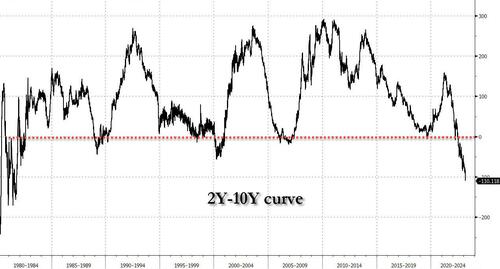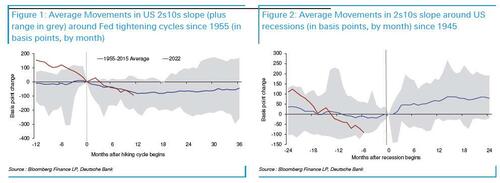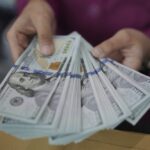
Yesterday, the spread between 2- and 10-year yields rose above 1% (and in the past 24 hours yield curve has blown out another 10bps to 110bps) for the first time since 1981, when Paul Volcker was engineering hikes that broke the back of double-digit inflation at the cost of a lengthy recession and millions of unemployed workers.
A similar dynamic is unfolding now, according to Ken Griffin, the chief executive officer and founder of hedge fund giant Citadel. “We have the setup for a recession unfolding” as the Fed responds to inflation, Griffin told Bloomberg in an interview in Palm Beach.
“Every time they take the foot off the brake, or the market perceives they’re taking their foot off the brake, and the job’s not done, they make their work even harder,” Griffin said.
What does the the historical record say?
One question history can help answer, is how long this continued deep inversion could last. Here is what DB's Jim Reid found when asking just this question:
- If we look at the last 70 years of hiking cycles, we can see that the curve on average flattens from around the first hike to 12 months after. It then stabilizes for 6 months and then starts steepening.
- Alternatively, if we look at what happens before a recession, on average the curve hits its most inverted around 3 months prior to a recession before seeing a substantial steepening over the next 12-18 months, especially in the first three months of the recession.
What do DB's rates strategists’ think? They expect that by year-end 2023, the 2s10s will uninvert back to +45bps, so some 135bps steeper than current levels. While that sounds a huge move, Reid notes that "it’s not too far out of line with what you would expect if there was a recession in H2." To be sure, investors are not currently in a rush to buy the front end though given current inflation risks, and are looking for evidence of labor market weakness or more clarity on fiscal tightening from debt ceiling negotiations before they do. However if and when it happens, the curve can steepen quite quickly if history is to be believed, Reid warns.
How about those historical cases when we saw an inversion as big as today's? Here Reid calculates that on all the previous occasions that the 2s10s has been more than -100bps inverted since data is available from the early 1940s (there are just four of these - 1969, 1979, 1980 and 1981) a recession has either been underway, or has occurred within a maximum of 8 months.
And just to highlight how rare the current inversion truly is, Reid says that there have only been 7-month end closes lower than -100bps in 80 years of available data: "so we are in rarefied air."
Yesterday, the spread between 2- and 10-year yields rose above 1% (and in the past 24 hours yield curve has blown out another 10bps to 110bps) for the first time since 1981, when Paul Volcker was engineering hikes that broke the back of double-digit inflation at the cost of a lengthy recession and millions of unemployed workers.
A similar dynamic is unfolding now, according to Ken Griffin, the chief executive officer and founder of hedge fund giant Citadel. “We have the setup for a recession unfolding” as the Fed responds to inflation, Griffin told Bloomberg in an interview in Palm Beach.
“Every time they take the foot off the brake, or the market perceives they’re taking their foot off the brake, and the job’s not done, they make their work even harder,” Griffin said.
What does the the historical record say?
One question history can help answer, is how long this continued deep inversion could last. Here is what DB’s Jim Reid found when asking just this question:
- If we look at the last 70 years of hiking cycles, we can see that the curve on average flattens from around the first hike to 12 months after. It then stabilizes for 6 months and then starts steepening.
- Alternatively, if we look at what happens before a recession, on average the curve hits its most inverted around 3 months prior to a recession before seeing a substantial steepening over the next 12-18 months, especially in the first three months of the recession.
What do DB’s rates strategists’ think? They expect that by year-end 2023, the 2s10s will uninvert back to +45bps, so some 135bps steeper than current levels. While that sounds a huge move, Reid notes that “it’s not too far out of line with what you would expect if there was a recession in H2.” To be sure, investors are not currently in a rush to buy the front end though given current inflation risks, and are looking for evidence of labor market weakness or more clarity on fiscal tightening from debt ceiling negotiations before they do. However if and when it happens, the curve can steepen quite quickly if history is to be believed, Reid warns.
How about those historical cases when we saw an inversion as big as today’s? Here Reid calculates that on all the previous occasions that the 2s10s has been more than -100bps inverted since data is available from the early 1940s (there are just four of these – 1969, 1979, 1980 and 1981) a recession has either been underway, or has occurred within a maximum of 8 months.
And just to highlight how rare the current inversion truly is, Reid says that there have only been 7-month end closes lower than -100bps in 80 years of available data: “so we are in rarefied air.”
Loading…






